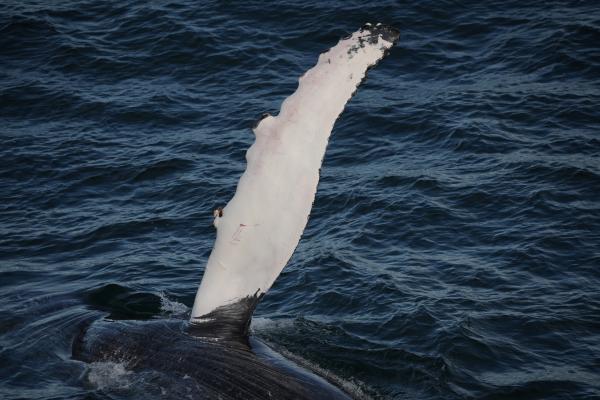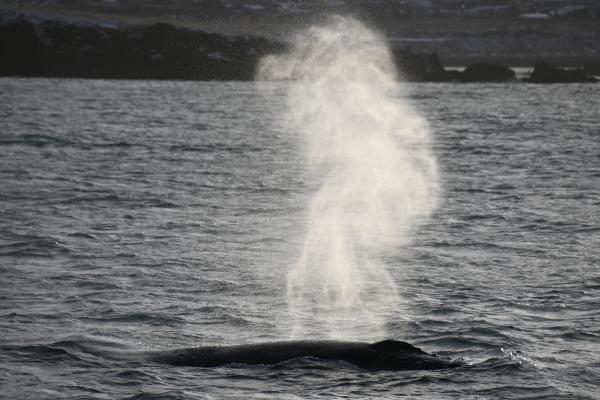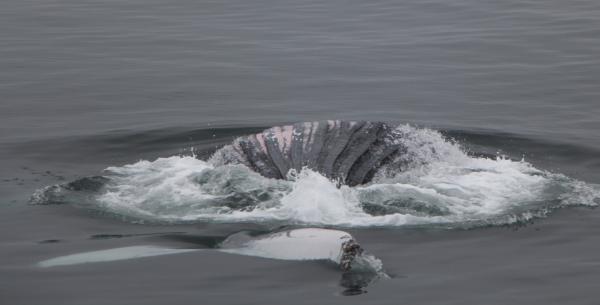
Humpback whales have for long captivated humans due to their complexity, making them one of the most studied cetaceans in our world's oceans. Their intelligence, social behaviours and diverse surface activities have gained significant interest of researchers around the world. They exhibit a rich array of fascinating behaviours, contributing to our understanding of their intricate social structures and ecological roles in the marine ecosystem.
In nature documentaries, the iconic sight of a humpback whale breaching captivates audiences. However, besides breaching, humpback whales engage in various other surface activities such as pectoral and tail slapping and rolling. These behaviours serve multiple potential functions: they may help remove parasites from the whales' skin, startle prey, or serve as communication signals.
Although it is impossible to predict what is going to happen on our tours, our sighting data from 2022 shows that we observed the highest proportion of surface activity from humpback whales during the early summer. Additionally, they were also more active during our evening tours, compared to our morning and afternoon tours. It is however important to keep in mind that whale watching with Elding is not a performance, but rather, a unique opportunity to encounter the majestic creatures in their natural habitat, allowing them to dictate the pace on their own terms. Our emphasis has always been on operating whale friendly tours, adhering to responsible whale watching guidelines. This may entail maintaining distance to honour their habitat or relocating if there's congestion from multiple boats in one area.
We anticipate that the insights gained from our research into social organisation and behaviour patterns, provide a comprehensive understanding of humpback whales as complex beings. This knowledge not only enriches our appreciation for these remarkable creatures but also enhances conservation efforts aimed at safeguarding their welfare and habitats for generations to come.

Surfacing
Humpback whales are easy to identify, as they look very different from most other baleen whales. They have a dark grey body with tubercles on their head and snout and have a distinctive hump just above their dorsal fin. These features are usually very prominent during surfacing.
When a humpback whale surfaces, it typically starts by raising its head above the water level, followed by the appearance of the blowhole, through which the whale exhales forcefully, creating a distinctive spout or blow. The spout can reach heights of up to 4 meters (13ft) and is visible from a distance, making it easier to spot from afar.

Fluke up diving
When a humpback whale prepares to deep dive, it arches its back, and with a powerful downward thrust of its fluke, it submerges beneath the water's surface. These dives can last anywhere from a few minutes to over 15 minutes, depending on the whale's activity, such as feeding or resting, however the record is well over 30 minutes!
Humpback whales have distinct patterns on the underside of their flukes, which are unique to each individual, similar to a human fingerprint. They consist of irregular patches of pigmentation that they are born with and scars caused by injuries or parasites. Images of the underside of the fluke are often used by researchers and conservationists to identify and track individual whales over time, a practice known as photo identification. These photos provide valuable information for studying humpback whale population dynamics, migration patterns, social structure, and behaviour.

Breaching
Breaching is when a humpback whale propels itself out of the water, often with a twisting or rolling motion, and then lands back on the surface. While the exact reason for breaching is not fully understood, it's believed to serve multiple purposes such as the removal of parasites from their skin, stunning prey or communication through the resulting sound waves. Additionally, breaching may serve as social displays, indicating playfulness or relaxation, particularly when whales are observed in pairs.
In 2022, we observed the highest proportion of surface activity during the early summer and breaching was the most common behaviour; seen on 12% of all tours! So, if you come on a whale watching tour with Elding, there is a 1 in 10 chance that you might at least see one breach.

Pectoral slapping
Pectoral slapping involves the repeated slapping of one or both of humpback whales' large pectoral fins against the surface of the water. This action creates a distinctive sound and often generates big splashes. The exact function of pectoral slapping in humpback whales is not fully understood and may serve multiple purposes such as; communication, attracting attention, play, self cleaning. It often accompanies other behaviours such as breaching and tail slapping.

Tail slapping / lobtailing
Tail slapping or lobtailing is when a whale forcefully slapping its fluke on the surface of the water, creating a loud noise and a big splash. The exact function is not completely understood, although the sound and visual display could attract attention, assert dominance, or communicate agitation. It could also be playful during a social interaction. It could also be a way to stun or scare their prey into a denser school, making it easier to consume.
Unlike tail throws, where the entire tail is lifted clear out of the water, tail slaps typically only involve the fluke of the whale to be fully out of the water, with the rest of its body being submerged. Some whales may perform a series of consecutive tail slaps, with the flukes striking the water multiple times in rapid sequence.

Peduncle throwing
Peduncle throws (also known as tail throws), involves forcefully lifting the fluke out of the water before slamming it down onto the water's surface. This action creates a loud sound and often results in a large splash and wave. The peduncle refers to the muscular area at the base of the whale's fluke, which is responsible for powering their swimming movements.
While it is believed to be a form of communication for dominance, attention or socialising, there is data that suggests that humpback whales may perform peduncle throws when they are agitated or disturbed by external factors. This could be caused by boat traffic or nearby predators which are deterred by the sudden movement and noise.

Spy hopping
Spy hopping is when a whale vertically rises partially out of the water, exposing tubercles on the head and sometimes part of its body above the surface. This behaviour is thought to help the whale get a better view of its surroundings, including potential prey or predators.
This curious behaviour is sometimes observed on our tours, mainly when the weather is calm and the whales want to get a closer look at our passengers!

Logging
Logging refers to a resting behaviour where a whale remains floating passively, with little to no movement, resembling a log drifting on the water's surface. During logging, the whale keeps its blowhole exposed above the water to breathe periodically while conserving energy and recover from periods of activity, such as feeding or migration.
The duration of logging can vary widely among individual humpback whales and though some whales may log for just a few minutes, others may remain in a logging posture for several hours.

Rolling
Rolling behaviour refers to the movement where the whale rotates its body around its longitudinal axis and is often associated with feeding, especially when humpback whales are engaging in lunge feeding or bubble net feeding. When they roll, it can help them engulf more prey or effectively use their baleen plates to filter out water while retaining their food.
While it is not certain, scientists believe that rolling may simply be a way for whales to have fun, particularly among younger individuals or during periods of social interaction within a group. It could also serve a practical purpose related to the maintenance of their body, i.e. to help remove parasites or alleviate irritation.

Feeding
Iceland is an important feeding ground for humpback whales and to meet their energetic needs, particularly during the summer, they must consume large quantities of prey to build up fat reserves for their long migrations and periods of fasting. In fact, they can eat up to 1,5 metric tons a day!
Humpback whales in our region will most often use a method known as lunge feeding, which involves the whale rapidly accelerating towards a concentrated patch of krill or small fish, with its mouth wide open. As the whale lunges forward, it engulfs both prey and water before the water is expelled through the baleen plates, leaving the prey trapped inside the mouth for swallowing.
Another feeding strategy used by some humpback whales is bubble net feeding. This is a cooperative behaviour, where a group of whales release a spiralling ring of bubbles underwater, forming a "net" around a school of fish. The whales then swim upward through the bubble net, capturing the prey within their open mouths. While this is not very common amongst Icelandic humpback whales, we do have the pleasure of observing this very interesting technique from time to time!
While surface active behaviours like breaching and peduncle throwing are frequently witnessed in both breeding grounds in warmer waters and the Icelandic feeding grounds, the underlying motivations for these actions may vary in different regions. In the Icelandic feeding grounds, surface activity may be more related to foraging activities and communication about feeding, while the same behaviours more likely serve to impress the opposite sex or establish territories in the more social breeding areas.
Although we can never be too sure about the exact reasons why whales behave in certain ways, we can find out more about these mysterious, magnificent behaviours by analysing them within the frame of their environmental and social contexts. Thankfully, we have plenty of study material in Iceland, as the humpback whales are showing off their acrobatics more and more!




